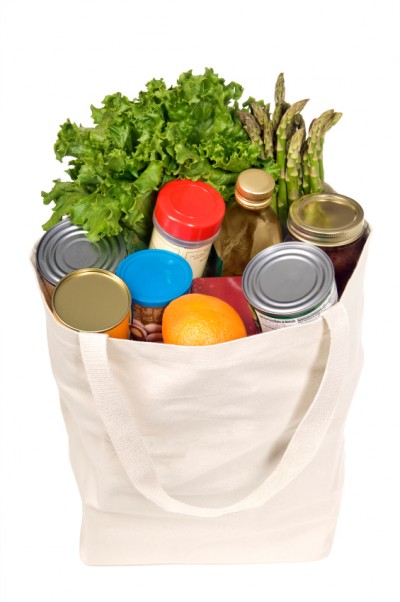In Checkout Line, Lou Bendrick cooks up answers to reader questions about how to green their food choices and other diet-related quandaries. Lettuce know what food worries keep you up at night.
—————
 Time to green the canned-food drive.From the Grist Twitter feed:
Time to green the canned-food drive.From the Grist Twitter feed:
Looking for healthy safe nonperishable foods to donate to food banks. Ideas?
— Janieo
Dear Janieo,
Thanks so much for this question. I must admit that sometimes I feel like I’m fiddling while Rome burns — prattling on about the merits of artisan chocolate while people go hungry.
To understand the issue of hunger better, I contacted Jean Kempe-Ware, public relations manager of the Oregon Food Bank. As it turns out, the Beaver State has the unfortunate rank of second in the nation when it comes to hunger (Mississippi is number one) and the demand for emergency food is rising. In an average month, the number of people who eat meals from an emergency food box through an Oregon Food Bank member agency jumped from an estimated 200,000 in 2007-08 to 240,000 in 2008-09.
“That’s enough people to fill the Rose Garden arena 12 times — in a month,” Kempe-Ware told me by email. Nationally, the picture isn’t pretty either. According to Feeding America, a study by the U.S. Department of Agriculture’s Economic Research Service showed that one in six Americans is “food insecure,” meaning that they live with hunger or fear of starvation. But that’s not the worst news: The New York Times reported just after Thanksgiving (irony of ironies) that food stamps now feed one in four children and one in eight Americans. Meanwhile, more and more older Americans are turning to food pantries to get by.
Now then, instead of curling into a ball and crying, let’s get off of our virtual asses (okay, technically our asses aren’t virtual — at least not mine, thanks to that pecan pie) and come up with some healthy, safe, nonperishable foods to take to the food pantry post-haste.
Here are some tips:
• For we greens, safe doesn’t just mean unspoiled, but also free of harmful chemicals. So, donate organic foods if your budget allows. If you can’t, don’t worry about it. “We welcome nutritious, organic food from sustainable sources,” said Kempe-Ware. “That said, emergency food boxes aren’t meant to supply the majority of food that a family eats. The average recipient receives an emergency food box two or three times a year.”
• If you can’t afford organic food (the unfairness of our food system, which makes healthy food a luxury and crappy food cheap, is another column entirely), you can make healthy choices by buying whole and single-ingredient foods and avoiding highly processed junk food (if the label has lots of unpronounceable ingredients, avoid it). Among the foods on the Oregon Food bank’s most-wanted nonperishable food list are canned or dried beans and peas (i.e., black, pinto, lentils) pasta, rice, and cereal.
• Canned goods are often preferred by pantries, but you should avoid cans lined with BPA. Steering your shopping cart clear of this nasty substance isn’t easy. But according to Amy Rosenthal, online outreach manager at the Environmental Working Group Eden Organic canned goods do not contain BPA. If you’re unsure about the liners in the cans you buy, call or email the company.
• Contact your local food bank and ask them for their donation guidelines. While buying food in glass containers skirts the BPA issue, not all food pantries will accept glass because it’s breakable. Consider donations that come in food-safe plastic containers (recycle numbers 5, 4, 1 & 2 are best), bags (such as a bag of rice), or cardboard boxes (such as 100 percent juice in juice boxes).
• If you’re going to dig through the back of your cupboards, check the fresh dates on labels. Kempe-Ware also says: “Please no rusty or unlabeled cans; perishable, homemade, noncommercial canned or packaged items; alcoholic beverages, mixes, or soda; open or used items; or glass containers.”
If vetting nonperishable choices is giving you a headache, there are plenty of other ways that you can help alleviate hunger. A food donation need not heed the musty canned-food drives of yesterday. Some food pantries are now distributing local, fresh food, including the Oregon Food Pantry.
“During harvest time, we welcome fresh produce from your garden.” So, consider planting an extra row in your garden this spring if your local pantry accepts fresh produce. You can also volunteer at a food bank or soup kitchen, and, needless to say, donate much-needed cold, hard cash (in many cases you can do this online). Also, remember pantries when the holidays are over and participate in food drives all year long. Or coordinate with a local pantry to host your own food drive. Did I mention advocate? Tweet away.
It’s easy for me to make fun of my Thanksgiving overindulgence, but I also know that nobody should go hungry in this country. Thanks for reminding us that that we can help solve this problem in a green way.
Happy Holidays, Janieo!
Lou



